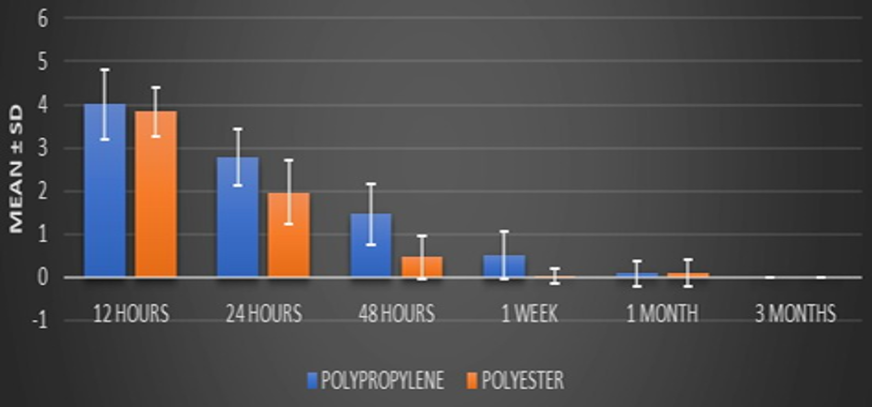A Randomised Control Trial in Comparison of Polypropylene Mesh Versus Polyester Mesh in Open Inguinal Hernia Repair
Abstract
One of the most common surgical problems presenting to the surgical OPD is Inguinal Hernia. Surgery being the main treatment for hernia, surgical techniques of inguinal hernia have undergone great development over centuries and decades. Lichtenstein’s tensionless hernia repair has revolutionized the procedure. It is one of the first surgeries learnt by a surgery resident. While hernia recurrence rates have drastically been brought down by the placement of mesh, post operative pain has become more troublesome in hernioplasty. Polyester is a softer pliable material than the routinely used polypropylene mesh offering the benefit of less post operative pain and improved quality of life Prospective single blinded randomized control trial involving 144 patients assigned to receive lichtenstein repair with polyester mesh (n=72) or polypropylene mesh (n=72). All the patients were operated on by a single surgeon to maintain uniformity and made sure that ilioinguinal, iliohypogastric and genitofemoral nerves were identified intraoperatively and preserved. Patients were observed in the hospital and visual analogue score for pain was recorded postoperatively at 12 hours, 24 hours, 48 hours, 1 week, 1 month and 3 months complications were also noted down and analyzed using two sample t test for continuous variable and Chi-square test for categorical variables. The conclusion from this study is that usage of Polyester mesh is comparable and slightly superior to that of Polypropylene in view of Post operative Pain, duration of Stay in the Hospital and patient acceptance. Further studies are needed to find the optimal mesh for inguinal hernia repair.
Full text article
References
B C Shah, M R Goede, R Bayer, S L Buettner, S J Putney, and C L Mcbride. Does type of mesh used have an impact on outcomes in laparoscopic inguinal hernia? Am J Surg, 198(6):759– 64, 2009.
M R Langenbach and S Sauerland. Polypropylene versus polyester mesh for laparoscopic inguinal hernia repair: short-term results of a comparative study. Surgical Sci, 4(01):29–34, 2013.
J E Morrison and V R Jacobs. Laparoscopic Preperi-toneal Inguinal Hernia Repair Using Preformed Polyester Mesh without Fixation: Prospective Study with 1-year Follow- Up Results in a Rural Setting. Surgical Laparoscopy Endoscopy & Percutaneous Techniques, 18:33–39, 2008.
G Chatzimavroudis, I Koutelidakis, B Papaziogas, T Tsaganos, P Koutoukas, and E Giamarellos-Bourboulis. The effect of the type of intraperitoneally implanted prosthetic mesh on the systemic inflammatory response. Hernia, 12(3):277–83, 2008.
M Bay-Nielsen, E Nilsson, P Nordin, and H Kehlet. Chronic pain after open mesh and sutured repair of indirect inguinal hernia in young males. Br J Surg, 91(10):1372–1376, 2004.
S W Nienhuijs, O B Boelens, and L J Strobbe. Pain after anterior hernia repairs. J Am Coll Surg, 200(6):885–889, 2005.
B Sadowski, J Rodriguez, R Symmonds, J Roberts, J Song, M H Rajab, C Cummings, and B Hodges. Comparison of polypropylene versus polyester mesh in the Lichtenstein hernia repair with respect to chronic pain and discomfort. Hernia, 15(6):643–654, 2011.
W Mui, C Ng, T Fung, F Cheung, T Ma, M Bn, and E Ng. Prophylactic ilioinguinal neurectomy in open inguinal hernia. Ann Surg, 244(1):27–33, 2006.
M J Rosen. Polyester-based mesh for ventral hernia repair: is it safe? Am J Surg, 197(3):353–359, 2009.
A D Sutaria, A N Bhedi, M L Sindhal, and A A Sarkar. Comparative study of polyester vs polypropylene mesh in laparoscopic inguinal hernia repair. International Surgery Journal, 6(2):531–536, 2019.
Authors

This work is licensed under a Creative Commons Attribution-NonCommercial-NoDerivatives 4.0 International License.





